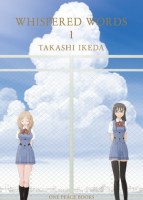 Creator: Takashi Ikeda
Creator: Takashi Ikeda
U.S. publisher: One Peace Books
ISBN: 9781935548454
Released: May 2014
Original release: 2007-2008
Whispered Words is a nine-volume yuri manga series by Takashi Ikeda published in Japan between 2007 and 2011. It’s probably his most popular work, or a least his best-known work, and the early part of the manga was even adapted as a thirteen-episode anime series in 2009. Despite my interest in yuri manga and the series’ following, I actually didn’t know much about it until I discovered that One Peace Books had licensed the work for English release. Whispered Words, Omnibus 1, released in 2014, collects the first three volumes of the series originally published in Japan between 2007 and 2008. Considering that comparatively few yuri manga have been released in English, I was happy for the opportunity to read more in translation. Because of the excited murmuring from fans surrounding the licensing of the series, I was particularly glad for the chance to read Whispered Words. And, except for some poor editing and lettering by One Peace Books, generally I was not disappointed. Plus, it even has karate in addition to yuri!
Sumika “Violence” Murasame, a high-school first year, is in love with her classmate and best friend Ushio Kazama. Ushio likes girls, too, but the problem is that she only likes “cute” girls. Unfortunately, Sumika has come to the conclusion that she is decidedly un-cute. She’s taller than most people, athletically and academically gifted, and a genius at karate (which is what earned her her nickname). But Sumika would gladly give all of that up to become small, delicate, and cute in order to fit Ushio’s type. That’s not really a possibility, though. So instead of admitting her feelings to Ushio and potentially ruining their friendship, Sumika has chosen to keep them to herself. It’s difficult and can be painful at times, but more than anything else Sumika wants Ushio to be happy. Eventually, other classmates become aware of Sumika’s feelings for Ushio, so it seems that it’s only a matter of time before they become obvious to Ushio as well.
Although at its heart Whispered Words has a fairly serious story about friendship and unrequited love, there is also a very strong comedic element to the series. Personally, I found the silliness of the manga and the characters themselves all to be very charming. For the most part, the underlying story and relationships in Whispered Words are actually fairly realistic. However, Ikeda regularly throws in something completely outrageous, such as an impeccably timed exploding SUV or indulging in his penchant for finding any excuse to dress everyone up in maid costumes. Whispered Words can admittedly be a bit ridiculous at times, but it’s not necessarily a bad thing. Ikeda strikes an excellent balance between the series’ humor and its more serious aspects, making for a read that is both entertaining and heartfelt. Ikeda’s artwork also reflects this duality. He effectively captures the more emotional moments—the tears, the pining, and the heartbreak, as well as the happiness and joy—but he can just as easily slip into a more comedic mode with over-the-top reactions, dynamic expressions, and exuberant poses.
The characters in Whispered Words are what really make the series work for me—not only the two leads, but their friends, families, and classmates, too. I am particularly fond of Sumika and her development, though. She so desperately wants to be something the she’s not, but it’s when she allows herself to really be who she is that she shines. This growth and the evolution of her relationship with Ushio is explored in stages in Whispered Words, often through her relationships with other characters. Tomoe Hachisuka and Miyako Taema, with whom she becomes friends, are a couple that show a lesbian relationship is not something to be ashamed of. Akemiya Masaki and Azusa Aoi are classmates who prove that others already think that Sumika is cute and admire her. The petite Charlotte Munchausen is devoted to karate, follows Sumika’s guidance, and provides an example that strength and cuteness aren’t inherently mutually exclusive. Even when played for laughs, all of these relationships are incredibly important to Sumika and are what allow her to grow as a person and will hopefully allow her to grow even closer to Ushio.




